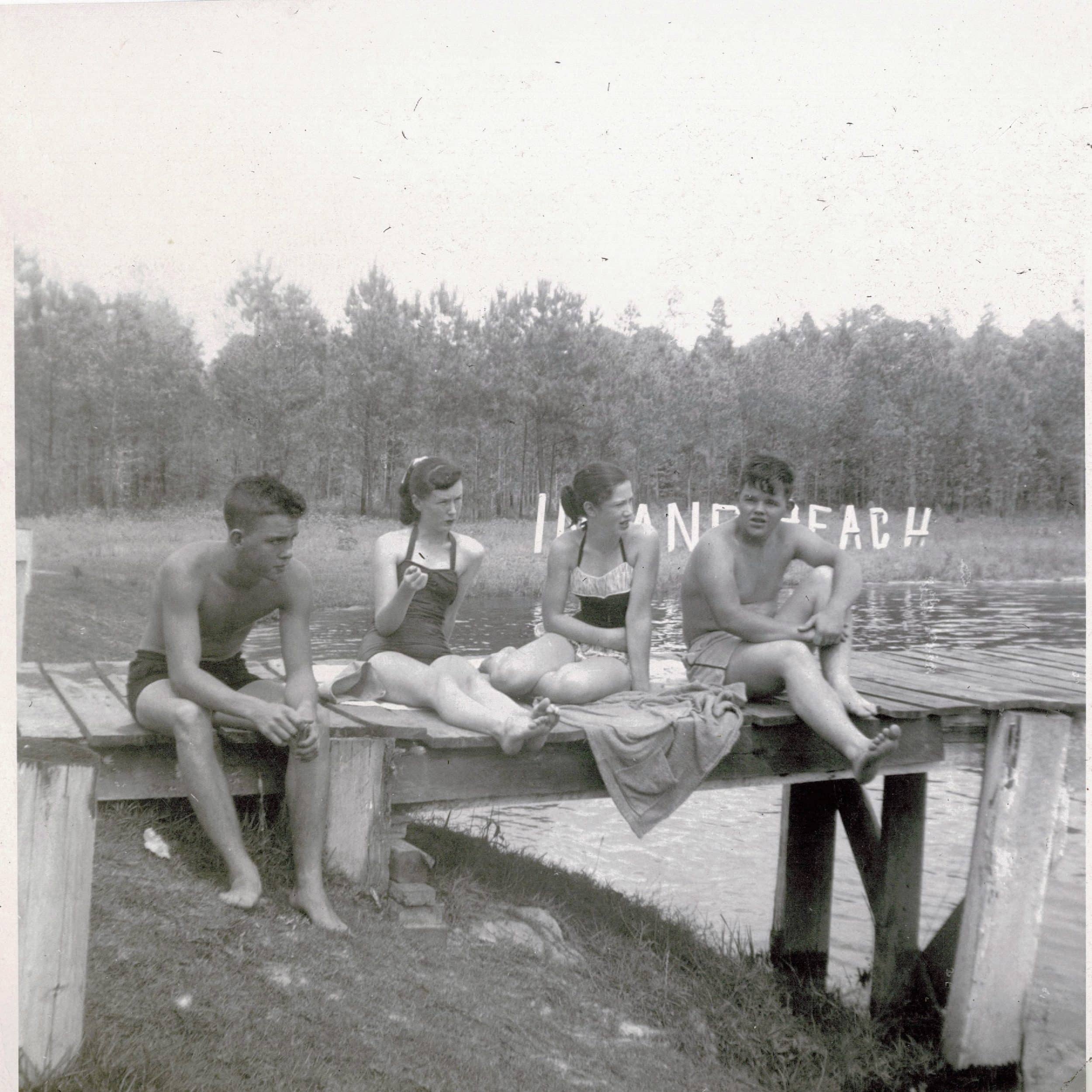Inland Beach was all the rave and memories among locals are as vivid as were the large letters on the back side of the pool.
On the north side of the pool painstakingly crafted timber poles spelled the words “Inland Beach” in capital letters, one by one, like California’s “Hollywood” sign. The pool, located on the outskirts of Lucedale, was a one-acre, sandy bottom, spring-fed lake. In its heyday, 1949-1962, Inland Beach was the only public pool between Hattiesburg and Mobile. Another public pool and a country club opened in the late 1960s and early 1970s, but Inland Beach was the place to be until 1977 when it closed to the public.
Some folks who remember it never got a chance to swim there as they were passersby motoring along the highway. The ones with the most vivid memories are those lucky enough to have swum there. It featured a slide, a rope swing, a low dive and a high dive. The 10-foot-tall high dive served as a test rite of passage among young boys.
Take Scott Hunter, for example. The Alabama quarterback/sportscaster/television personality earned his rites of passage at the pool while growing up in Lucedale. He fondly remembers riding his bicycle from town to Inland Beach during his younger years.
“So, there I was on the high dive platform at Inland Beach. It looked like it was 40 feet high and it might have been. The older bully boys were telling me that I wasn’t going to go back down the ladder. I had to dive off or else. My first dive off that high dive! Later the big bully boys were playing ‘shark’ behind the big rope swing platform and daring me to dive in and escape by them. If they caught you, they’d hold you submerged till you were out of air. I dove in and toed the sand sticking to the bottom to circle around all them and surface without getting caught,” Hunter said. “As time went on, the Sunday afternoons at Inland Beach revealed the tanned beautiful high school girls in two-piece bathing suits. No names mentioned for they know who they were but never a prettier sight for a 14/15-year-old boy.”
Danny Wayne Pipkins has memories similar to Hunter. “We’d spend the day out there.”
“The slide was on the pier inside the gate. The low dive was there. You’d swim from the low dive to the high dive,” Pipkins said. “The high dive was a rite of passage.”
For Mark Maples, Inland Beach was the place he learned to swim through American Red Cross lessons. Another memory he has involves frozen Snicker candy bars. His mother tried freezing Snickers at home, but they never tasted as good as those at Inland Beach.
Mavis Dungan, whose aunt and uncle, Minnie and Marion Havis, created Inland Beach, said a frozen Snicker cost 5 cents and was their biggest seller. “It was Uncle Marion’s idea to freeze them. They were a big hit. He froze Milky Way bars too, but the Snickers outsold the Milky Way five to one,” she said. “They also sold popsicles and small boxes of ice cream, but that was not nearly as popular as the frozen Snickers.”
Dungan said, “My daughter Joy says the reason they Snickers were so much better at Inland Beach than any attempt of freezing them at home was because when you ate a Snicker bar at Inland Beach you couldn’t help but get a little sand, grit and pool water in each bite.”
The pool and café were so popular because nothing like it existed nearby at that time. According to Dungan, on Saturday and Sunday afternoons the parking lot filled completely requiring latecomers to park along the roadside. The late Nellie Dean Horn once told Dungan that she and Pat Bryan, who is also now deceased, took their children to Inland Beach every day of the week except weekends. “Their husbands were home from work on Saturdays and church was on Sundays. It wasn’t a matter of whether they were going during the week. Instead, it was a matter of whether they’d pack a picnic lunch or buy hamburgers from the café.”
A hamburger from the café was 15 cents. Fries were about 10 cents. A plate lunch that included an entrée, two vegetables, dessert and beverage was 75 cents. “And it cost 25 cents to swim. You could get a season ticket. I’m not sure how much those were, maybe $10 or $15 for the summer.”
Carloads of mothers not only took their children to swim there, but also carried their garden-fresh vegetables. “The ladies would sit there visiting and shelling peas and butterbeans while their children played and swam,” Dungan said.
Another novelty about Inland Beach was the music. Friday and Saturday nights drew crowds to hear local bands who played just inside the café door near the jukebox. Speakers broadcasted the music both inside and outside for not only the musicians but also songs playing from the jukebox. The jukebox carried all the popular country songs of that time period. You could play one song for 10 cents or three for a quarter.
No wonder Inland Beach was all the rave.
Award-winning journalist Nancy Jo Maples has been writing about Mississippi people and places for more than 30 years. Contact her at [email protected].




